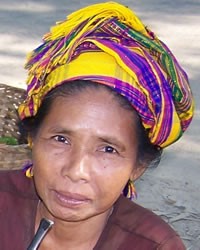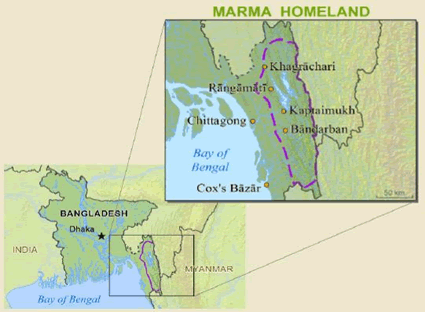Centuries ago, the most feared pirates and sailors in the Bay of Bengal terrorized communities along the seacoast and far up the river channels of what is now Bangladesh. People called them maghs, or pirates. This continues to be the popular name of this tribe, originally from the Arakan region of Myanmar.
The people themselves dislike the term "Magh" and prefer to be called Marmas, which means "Burmese." They are of Thai origin. They came through Arakan after their ancestors were driven out of China. They speak Arakanese, a Tibeto-Burman language, and regard Myanmar as the center of their cultural life. The Marma continue to write and dress in ways similar to Burmese culture.
Today, most live in the Chittagong Hills area of southeastern Bangladesh. There is a smaller group of them that borders that region in northeastern India.
Having left the seas long ago, the Marma are now valley farmers. Forced out of the plains and into the hills by more powerful groups, they have adopted the "slash and burn" method of agriculture. In their society, farmland is community property. After one year's use, the field must be left fallow for a sufficient time to let the land recover. After the fallow period, anyone and everyone can work in this field. No individual, family, or kinship group has prerogative rights to the land. Farming and other activities tie families to the community and the community to families.
According to their custom, marriages must be within the clan. Marma villages comprise 10 to 50 houses built on the banks of streams. The houses are flimsy structures constructed on bamboo piles. Often, a roofed platform at the end of the village street serves as a community house where men socialize, share stories and discuss village business.
They are folk Buddhists who believe in reincarnation, but also in spirits and ghosts who can make life miserable.
Although several religions are represented among the Marma, the most common religion is a blend of Buddhism and animism (belief that non-human objects have spirits). The theology of Buddhism alleges that man undergoes a cycle of separate existences and that all living things have individual souls. A devout Buddhist can progress toward his goal of nirvana—a state of eternal bliss—through the accumulation of merit-earning acts.
The animistic ingredient includes the worship and appeasement of local spirits, such as house spirits, village spirits, and territorial spirits, which rule over rice fields, forests, lakes, rivers, and other places. In order to avoid accidents, misfortune, and illnesses, one must try to manipulate and placate the spirits through rituals and offerings of food and flowers. Male and female mediums enter trances to communicate with the spirits so that they might discover future events.
The Marma people who live in northeastern India don't live far from vibrant believers. They need Christ followers to take the ways of the Savior to them. Perhaps someone who can help them get a higher yield for their crops can also reap a harvest among these Buddhists.
Pray that God will send culturally sensitive missionaries who will show them the way to the cross.
Pray for a Christ-ward movement to flourish among the Marma people in the 2020s.
Pray for the Marma people to be blessed with peace, joy and spiritual prosperity as they follow Jesus Christ.
Pray for their leaders to have dreams and visions that will open their hearts to Jesus Christ and his ambassadors.
Scripture Prayers for the Marma (Magh) in India.
| Profile Source: Joshua Project |












